Organisational Behaviour Report: ALDI Case Study Analysis
VerifiedAdded on 2020/12/10
|12
|3196
|446
Report
AI Summary
This report provides a comprehensive analysis of organisational behaviour within ALDI, a UK-based retail company. The introduction highlights the significance of organisational behaviour in enhancing employee productivity. Task 1 delves into ALDI's organisational culture, differentiating between various types like clan, power, market, and role cultures, and exploring organisational power and politics. Task 2 examines motivational theories, including content theories (Maslow's hierarchy, Alderfer's ERG, Herzberg's) and process theories (Vroom's expectancy, equity, goal-setting), and suggests motivational techniques. Task 3 focuses on the factors of an effective team, discussing different team types (departmental, problem-solving, virtual, self-managed) and the Tuckman model of team development. It also outlines characteristics of an effective team, such as goal clarity and effective processes. Task 4 introduces the concept and philosophies of organisational behaviour, with a focus on the Path Goal Theory, developed by Martin Evans, and its relevance to ALDI's leadership and employee motivation. The report concludes by summarizing the key findings and implications for ALDI's organisational practices.
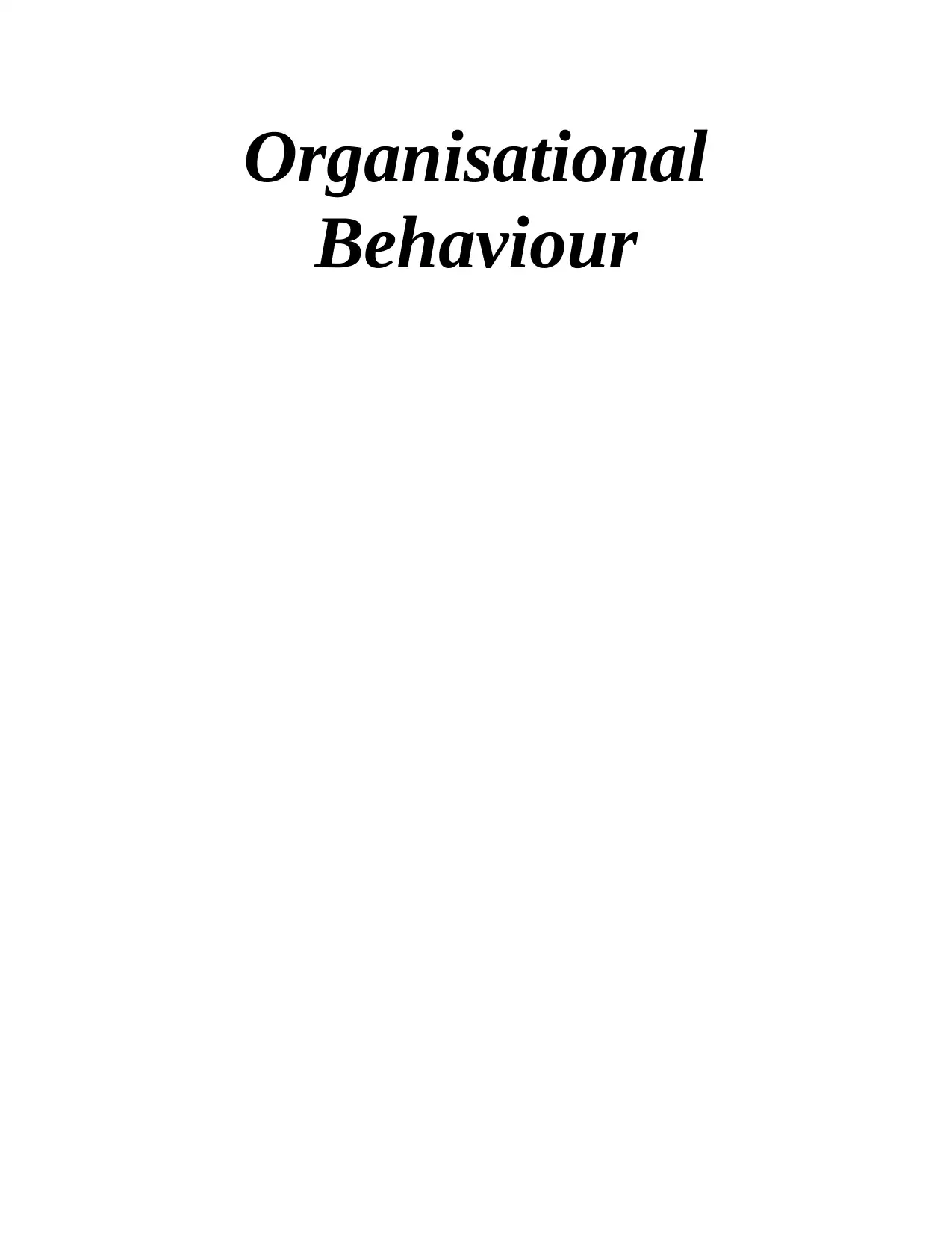
Organisational
Behaviour
Behaviour
Paraphrase This Document
Need a fresh take? Get an instant paraphrase of this document with our AI Paraphraser
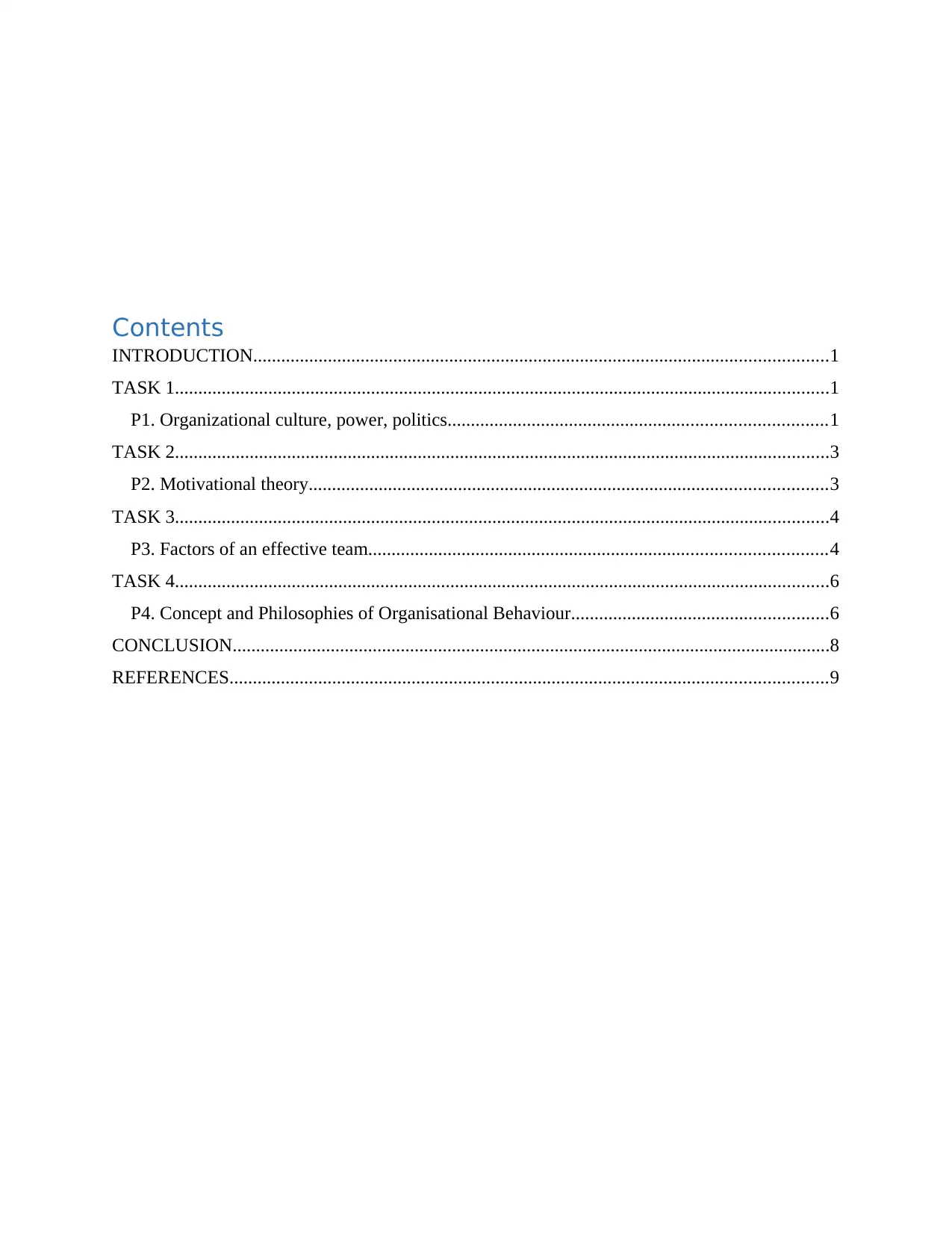
Contents
INTRODUCTION...........................................................................................................................1
TASK 1............................................................................................................................................1
P1. Organizational culture, power, politics.................................................................................1
TASK 2............................................................................................................................................3
P2. Motivational theory...............................................................................................................3
TASK 3............................................................................................................................................4
P3. Factors of an effective team..................................................................................................4
TASK 4............................................................................................................................................6
P4. Concept and Philosophies of Organisational Behaviour.......................................................6
CONCLUSION................................................................................................................................8
REFERENCES................................................................................................................................9
INTRODUCTION...........................................................................................................................1
TASK 1............................................................................................................................................1
P1. Organizational culture, power, politics.................................................................................1
TASK 2............................................................................................................................................3
P2. Motivational theory...............................................................................................................3
TASK 3............................................................................................................................................4
P3. Factors of an effective team..................................................................................................4
TASK 4............................................................................................................................................6
P4. Concept and Philosophies of Organisational Behaviour.......................................................6
CONCLUSION................................................................................................................................8
REFERENCES................................................................................................................................9

⊘ This is a preview!⊘
Do you want full access?
Subscribe today to unlock all pages.

Trusted by 1+ million students worldwide
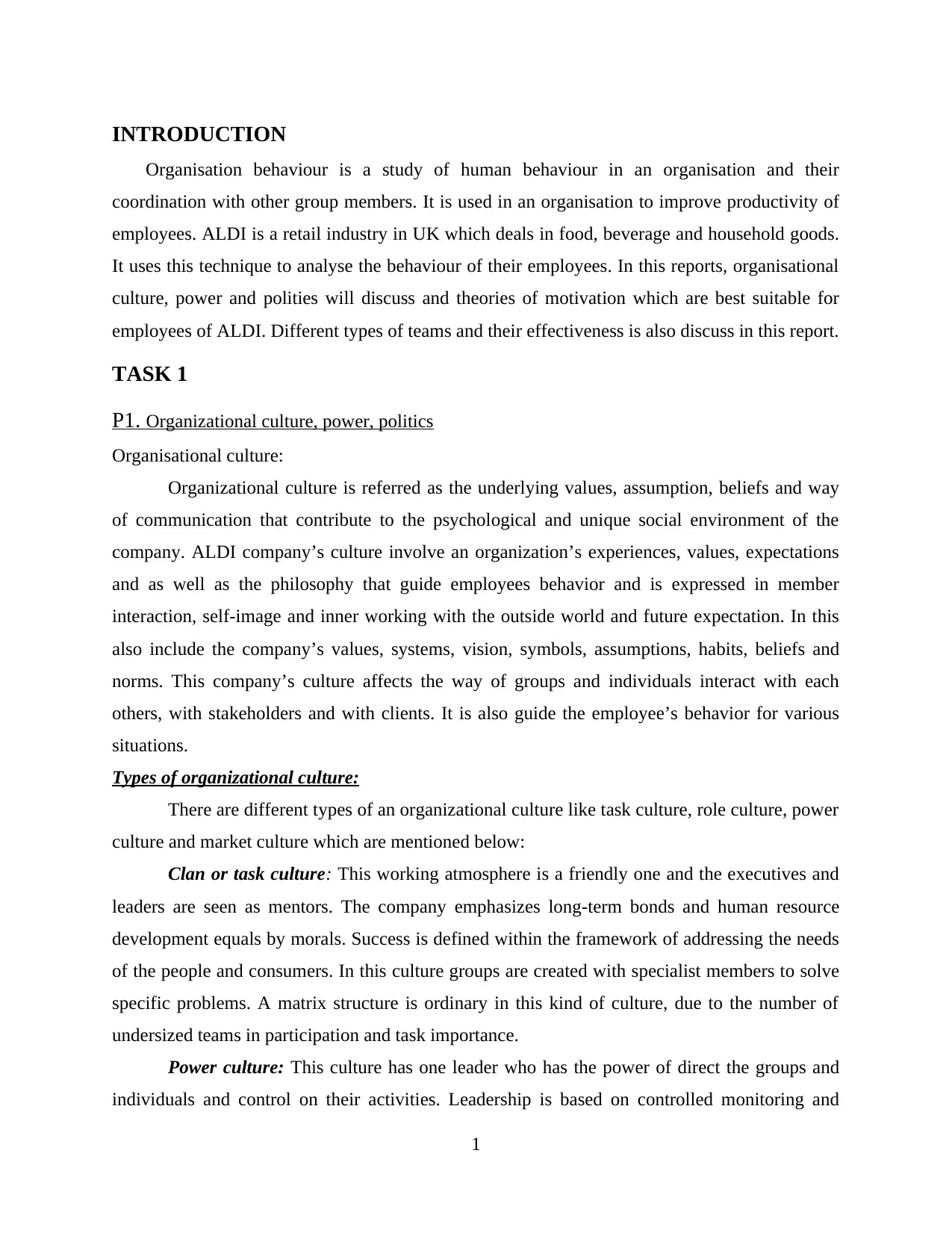
INTRODUCTION
Organisation behaviour is a study of human behaviour in an organisation and their
coordination with other group members. It is used in an organisation to improve productivity of
employees. ALDI is a retail industry in UK which deals in food, beverage and household goods.
It uses this technique to analyse the behaviour of their employees. In this reports, organisational
culture, power and polities will discuss and theories of motivation which are best suitable for
employees of ALDI. Different types of teams and their effectiveness is also discuss in this report.
TASK 1
P1. Organizational culture, power, politics
Organisational culture:
Organizational culture is referred as the underlying values, assumption, beliefs and way
of communication that contribute to the psychological and unique social environment of the
company. ALDI company’s culture involve an organization’s experiences, values, expectations
and as well as the philosophy that guide employees behavior and is expressed in member
interaction, self-image and inner working with the outside world and future expectation. In this
also include the company’s values, systems, vision, symbols, assumptions, habits, beliefs and
norms. This company’s culture affects the way of groups and individuals interact with each
others, with stakeholders and with clients. It is also guide the employee’s behavior for various
situations.
Types of organizational culture:
There are different types of an organizational culture like task culture, role culture, power
culture and market culture which are mentioned below:
Clan or task culture: This working atmosphere is a friendly one and the executives and
leaders are seen as mentors. The company emphasizes long-term bonds and human resource
development equals by morals. Success is defined within the framework of addressing the needs
of the people and consumers. In this culture groups are created with specialist members to solve
specific problems. A matrix structure is ordinary in this kind of culture, due to the number of
undersized teams in participation and task importance.
Power culture: This culture has one leader who has the power of direct the groups and
individuals and control on their activities. Leadership is based on controlled monitoring and
1
Organisation behaviour is a study of human behaviour in an organisation and their
coordination with other group members. It is used in an organisation to improve productivity of
employees. ALDI is a retail industry in UK which deals in food, beverage and household goods.
It uses this technique to analyse the behaviour of their employees. In this reports, organisational
culture, power and polities will discuss and theories of motivation which are best suitable for
employees of ALDI. Different types of teams and their effectiveness is also discuss in this report.
TASK 1
P1. Organizational culture, power, politics
Organisational culture:
Organizational culture is referred as the underlying values, assumption, beliefs and way
of communication that contribute to the psychological and unique social environment of the
company. ALDI company’s culture involve an organization’s experiences, values, expectations
and as well as the philosophy that guide employees behavior and is expressed in member
interaction, self-image and inner working with the outside world and future expectation. In this
also include the company’s values, systems, vision, symbols, assumptions, habits, beliefs and
norms. This company’s culture affects the way of groups and individuals interact with each
others, with stakeholders and with clients. It is also guide the employee’s behavior for various
situations.
Types of organizational culture:
There are different types of an organizational culture like task culture, role culture, power
culture and market culture which are mentioned below:
Clan or task culture: This working atmosphere is a friendly one and the executives and
leaders are seen as mentors. The company emphasizes long-term bonds and human resource
development equals by morals. Success is defined within the framework of addressing the needs
of the people and consumers. In this culture groups are created with specialist members to solve
specific problems. A matrix structure is ordinary in this kind of culture, due to the number of
undersized teams in participation and task importance.
Power culture: This culture has one leader who has the power of direct the groups and
individuals and control on their activities. Leadership is based on controlled monitoring and
1
Paraphrase This Document
Need a fresh take? Get an instant paraphrase of this document with our AI Paraphraser
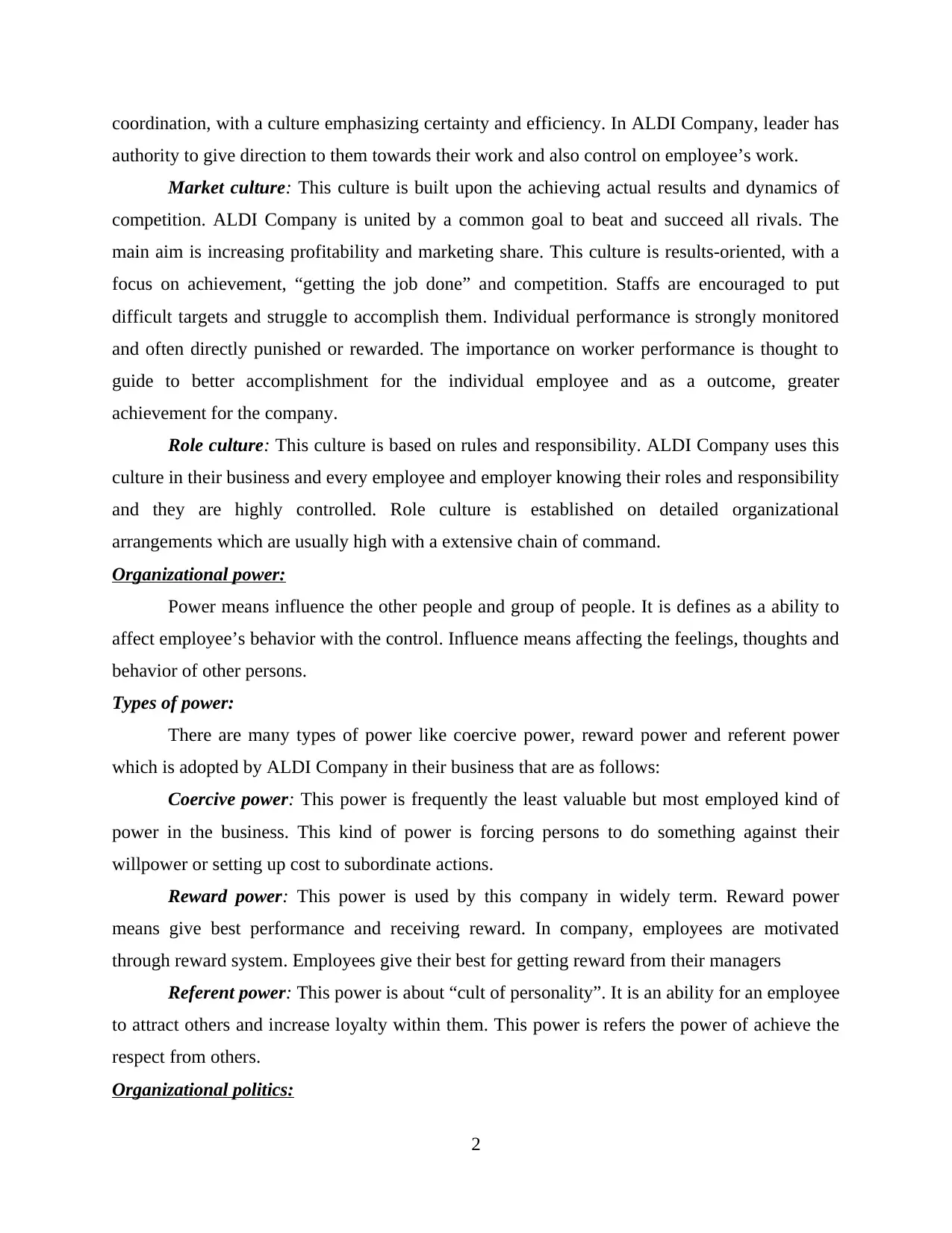
coordination, with a culture emphasizing certainty and efficiency. In ALDI Company, leader has
authority to give direction to them towards their work and also control on employee’s work.
Market culture: This culture is built upon the achieving actual results and dynamics of
competition. ALDI Company is united by a common goal to beat and succeed all rivals. The
main aim is increasing profitability and marketing share. This culture is results-oriented, with a
focus on achievement, “getting the job done” and competition. Staffs are encouraged to put
difficult targets and struggle to accomplish them. Individual performance is strongly monitored
and often directly punished or rewarded. The importance on worker performance is thought to
guide to better accomplishment for the individual employee and as a outcome, greater
achievement for the company.
Role culture: This culture is based on rules and responsibility. ALDI Company uses this
culture in their business and every employee and employer knowing their roles and responsibility
and they are highly controlled. Role culture is established on detailed organizational
arrangements which are usually high with a extensive chain of command.
Organizational power:
Power means influence the other people and group of people. It is defines as a ability to
affect employee’s behavior with the control. Influence means affecting the feelings, thoughts and
behavior of other persons.
Types of power:
There are many types of power like coercive power, reward power and referent power
which is adopted by ALDI Company in their business that are as follows:
Coercive power: This power is frequently the least valuable but most employed kind of
power in the business. This kind of power is forcing persons to do something against their
willpower or setting up cost to subordinate actions.
Reward power: This power is used by this company in widely term. Reward power
means give best performance and receiving reward. In company, employees are motivated
through reward system. Employees give their best for getting reward from their managers
Referent power: This power is about “cult of personality”. It is an ability for an employee
to attract others and increase loyalty within them. This power is refers the power of achieve the
respect from others.
Organizational politics:
2
authority to give direction to them towards their work and also control on employee’s work.
Market culture: This culture is built upon the achieving actual results and dynamics of
competition. ALDI Company is united by a common goal to beat and succeed all rivals. The
main aim is increasing profitability and marketing share. This culture is results-oriented, with a
focus on achievement, “getting the job done” and competition. Staffs are encouraged to put
difficult targets and struggle to accomplish them. Individual performance is strongly monitored
and often directly punished or rewarded. The importance on worker performance is thought to
guide to better accomplishment for the individual employee and as a outcome, greater
achievement for the company.
Role culture: This culture is based on rules and responsibility. ALDI Company uses this
culture in their business and every employee and employer knowing their roles and responsibility
and they are highly controlled. Role culture is established on detailed organizational
arrangements which are usually high with a extensive chain of command.
Organizational power:
Power means influence the other people and group of people. It is defines as a ability to
affect employee’s behavior with the control. Influence means affecting the feelings, thoughts and
behavior of other persons.
Types of power:
There are many types of power like coercive power, reward power and referent power
which is adopted by ALDI Company in their business that are as follows:
Coercive power: This power is frequently the least valuable but most employed kind of
power in the business. This kind of power is forcing persons to do something against their
willpower or setting up cost to subordinate actions.
Reward power: This power is used by this company in widely term. Reward power
means give best performance and receiving reward. In company, employees are motivated
through reward system. Employees give their best for getting reward from their managers
Referent power: This power is about “cult of personality”. It is an ability for an employee
to attract others and increase loyalty within them. This power is refers the power of achieve the
respect from others.
Organizational politics:
2
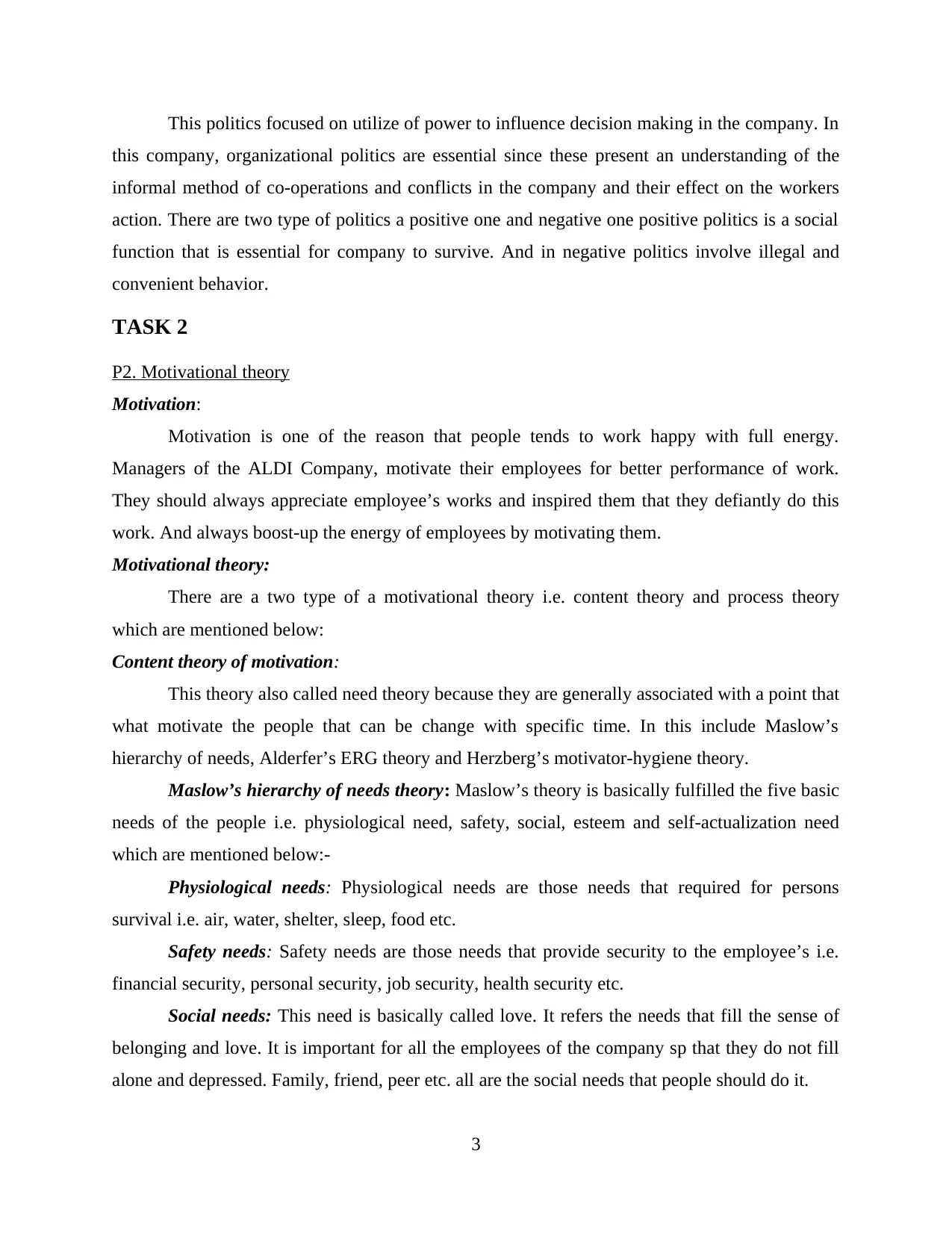
This politics focused on utilize of power to influence decision making in the company. In
this company, organizational politics are essential since these present an understanding of the
informal method of co-operations and conflicts in the company and their effect on the workers
action. There are two type of politics a positive one and negative one positive politics is a social
function that is essential for company to survive. And in negative politics involve illegal and
convenient behavior.
TASK 2
P2. Motivational theory
Motivation:
Motivation is one of the reason that people tends to work happy with full energy.
Managers of the ALDI Company, motivate their employees for better performance of work.
They should always appreciate employee’s works and inspired them that they defiantly do this
work. And always boost-up the energy of employees by motivating them.
Motivational theory:
There are a two type of a motivational theory i.e. content theory and process theory
which are mentioned below:
Content theory of motivation:
This theory also called need theory because they are generally associated with a point that
what motivate the people that can be change with specific time. In this include Maslow’s
hierarchy of needs, Alderfer’s ERG theory and Herzberg’s motivator-hygiene theory.
Maslow’s hierarchy of needs theory: Maslow’s theory is basically fulfilled the five basic
needs of the people i.e. physiological need, safety, social, esteem and self-actualization need
which are mentioned below:-
Physiological needs: Physiological needs are those needs that required for persons
survival i.e. air, water, shelter, sleep, food etc.
Safety needs: Safety needs are those needs that provide security to the employee’s i.e.
financial security, personal security, job security, health security etc.
Social needs: This need is basically called love. It refers the needs that fill the sense of
belonging and love. It is important for all the employees of the company sp that they do not fill
alone and depressed. Family, friend, peer etc. all are the social needs that people should do it.
3
this company, organizational politics are essential since these present an understanding of the
informal method of co-operations and conflicts in the company and their effect on the workers
action. There are two type of politics a positive one and negative one positive politics is a social
function that is essential for company to survive. And in negative politics involve illegal and
convenient behavior.
TASK 2
P2. Motivational theory
Motivation:
Motivation is one of the reason that people tends to work happy with full energy.
Managers of the ALDI Company, motivate their employees for better performance of work.
They should always appreciate employee’s works and inspired them that they defiantly do this
work. And always boost-up the energy of employees by motivating them.
Motivational theory:
There are a two type of a motivational theory i.e. content theory and process theory
which are mentioned below:
Content theory of motivation:
This theory also called need theory because they are generally associated with a point that
what motivate the people that can be change with specific time. In this include Maslow’s
hierarchy of needs, Alderfer’s ERG theory and Herzberg’s motivator-hygiene theory.
Maslow’s hierarchy of needs theory: Maslow’s theory is basically fulfilled the five basic
needs of the people i.e. physiological need, safety, social, esteem and self-actualization need
which are mentioned below:-
Physiological needs: Physiological needs are those needs that required for persons
survival i.e. air, water, shelter, sleep, food etc.
Safety needs: Safety needs are those needs that provide security to the employee’s i.e.
financial security, personal security, job security, health security etc.
Social needs: This need is basically called love. It refers the needs that fill the sense of
belonging and love. It is important for all the employees of the company sp that they do not fill
alone and depressed. Family, friend, peer etc. all are the social needs that people should do it.
3
⊘ This is a preview!⊘
Do you want full access?
Subscribe today to unlock all pages.

Trusted by 1+ million students worldwide
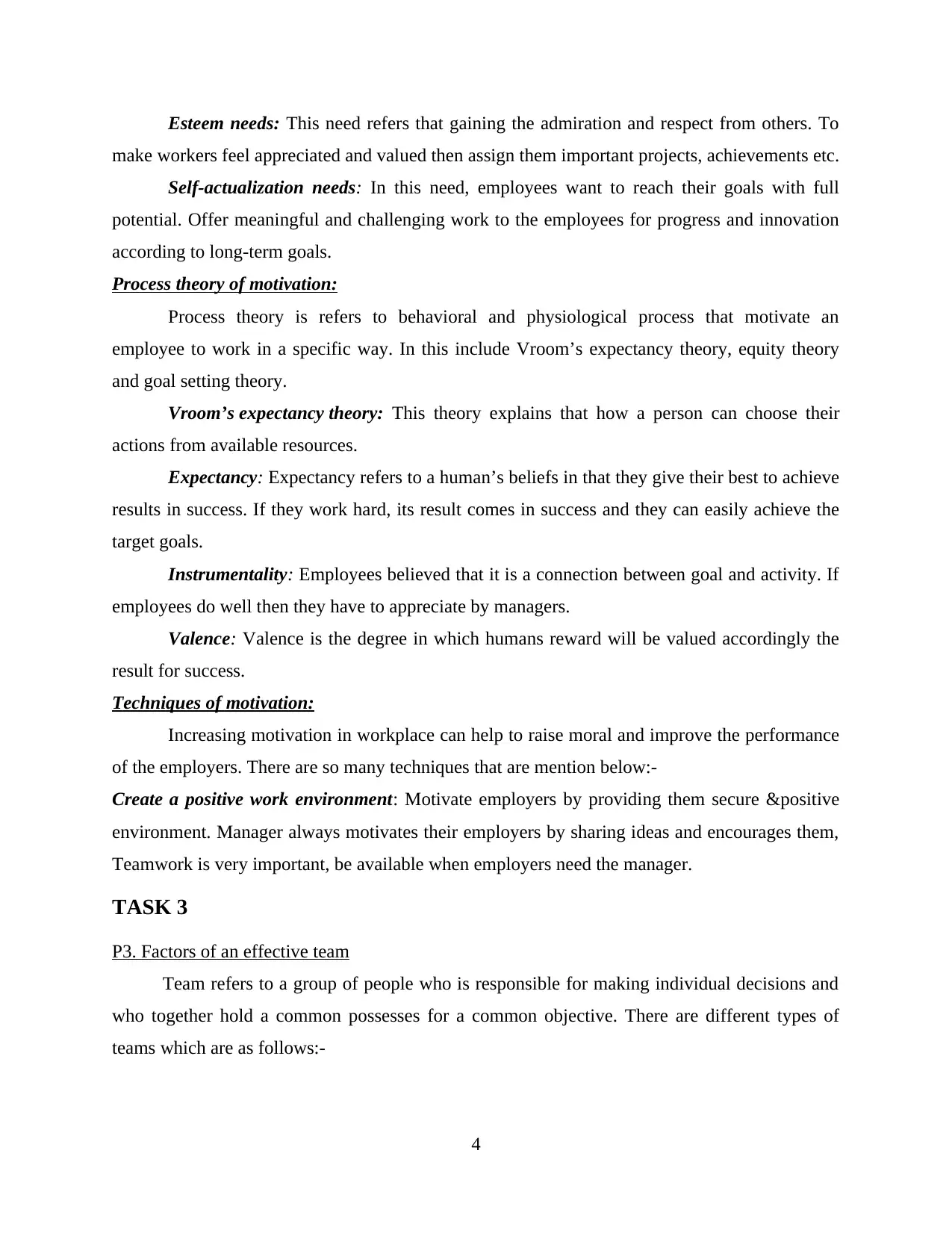
Esteem needs: This need refers that gaining the admiration and respect from others. To
make workers feel appreciated and valued then assign them important projects, achievements etc.
Self-actualization needs: In this need, employees want to reach their goals with full
potential. Offer meaningful and challenging work to the employees for progress and innovation
according to long-term goals.
Process theory of motivation:
Process theory is refers to behavioral and physiological process that motivate an
employee to work in a specific way. In this include Vroom’s expectancy theory, equity theory
and goal setting theory.
Vroom’s expectancy theory: This theory explains that how a person can choose their
actions from available resources.
Expectancy: Expectancy refers to a human’s beliefs in that they give their best to achieve
results in success. If they work hard, its result comes in success and they can easily achieve the
target goals.
Instrumentality: Employees believed that it is a connection between goal and activity. If
employees do well then they have to appreciate by managers.
Valence: Valence is the degree in which humans reward will be valued accordingly the
result for success.
Techniques of motivation:
Increasing motivation in workplace can help to raise moral and improve the performance
of the employers. There are so many techniques that are mention below:-
Create a positive work environment: Motivate employers by providing them secure &positive
environment. Manager always motivates their employers by sharing ideas and encourages them,
Teamwork is very important, be available when employers need the manager.
TASK 3
P3. Factors of an effective team
Team refers to a group of people who is responsible for making individual decisions and
who together hold a common possesses for a common objective. There are different types of
teams which are as follows:-
4
make workers feel appreciated and valued then assign them important projects, achievements etc.
Self-actualization needs: In this need, employees want to reach their goals with full
potential. Offer meaningful and challenging work to the employees for progress and innovation
according to long-term goals.
Process theory of motivation:
Process theory is refers to behavioral and physiological process that motivate an
employee to work in a specific way. In this include Vroom’s expectancy theory, equity theory
and goal setting theory.
Vroom’s expectancy theory: This theory explains that how a person can choose their
actions from available resources.
Expectancy: Expectancy refers to a human’s beliefs in that they give their best to achieve
results in success. If they work hard, its result comes in success and they can easily achieve the
target goals.
Instrumentality: Employees believed that it is a connection between goal and activity. If
employees do well then they have to appreciate by managers.
Valence: Valence is the degree in which humans reward will be valued accordingly the
result for success.
Techniques of motivation:
Increasing motivation in workplace can help to raise moral and improve the performance
of the employers. There are so many techniques that are mention below:-
Create a positive work environment: Motivate employers by providing them secure &positive
environment. Manager always motivates their employers by sharing ideas and encourages them,
Teamwork is very important, be available when employers need the manager.
TASK 3
P3. Factors of an effective team
Team refers to a group of people who is responsible for making individual decisions and
who together hold a common possesses for a common objective. There are different types of
teams which are as follows:-
4
Paraphrase This Document
Need a fresh take? Get an instant paraphrase of this document with our AI Paraphraser
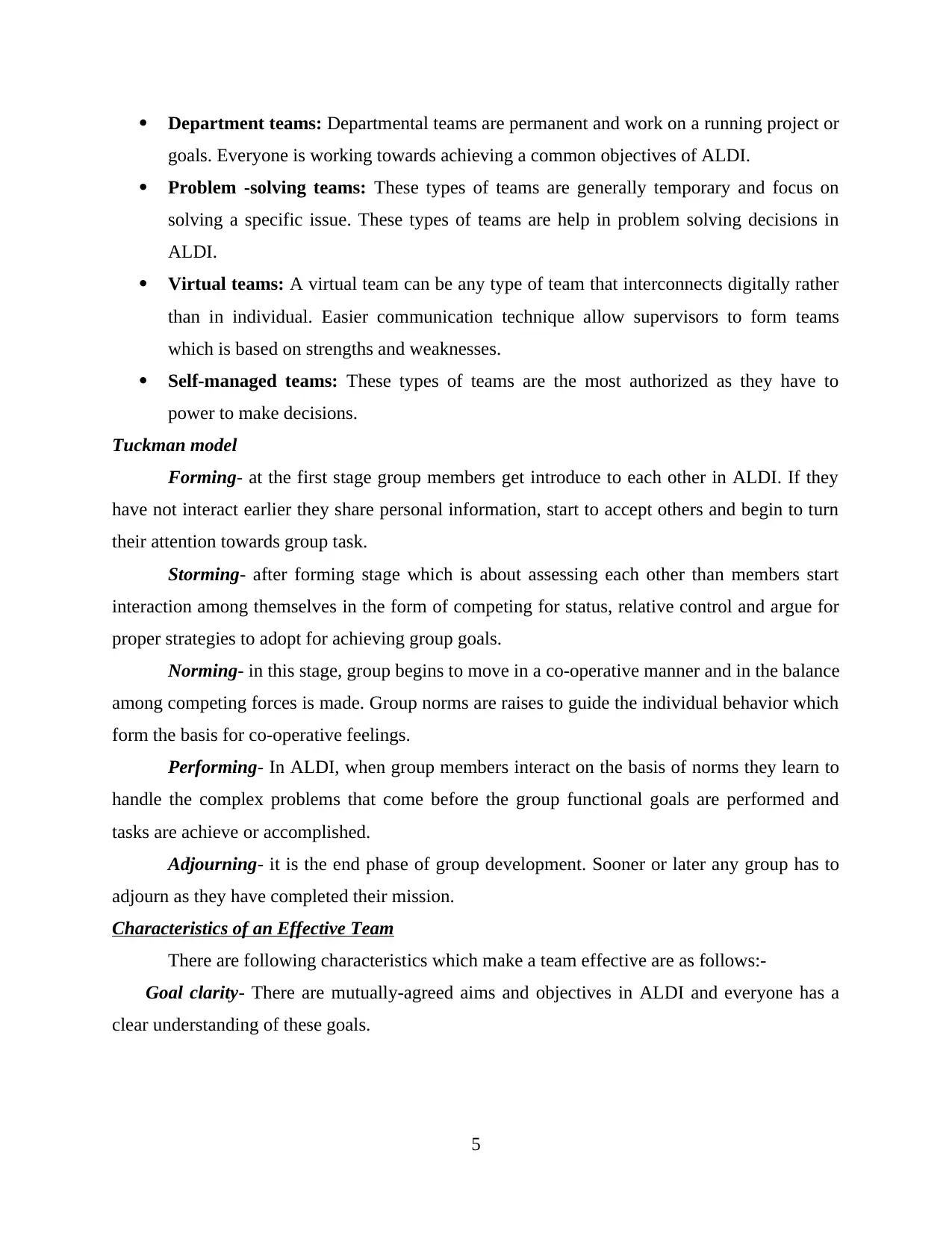
Department teams: Departmental teams are permanent and work on a running project or
goals. Everyone is working towards achieving a common objectives of ALDI.
Problem -solving teams: These types of teams are generally temporary and focus on
solving a specific issue. These types of teams are help in problem solving decisions in
ALDI.
Virtual teams: A virtual team can be any type of team that interconnects digitally rather
than in individual. Easier communication technique allow supervisors to form teams
which is based on strengths and weaknesses.
Self-managed teams: These types of teams are the most authorized as they have to
power to make decisions.
Tuckman model
Forming- at the first stage group members get introduce to each other in ALDI. If they
have not interact earlier they share personal information, start to accept others and begin to turn
their attention towards group task.
Storming- after forming stage which is about assessing each other than members start
interaction among themselves in the form of competing for status, relative control and argue for
proper strategies to adopt for achieving group goals.
Norming- in this stage, group begins to move in a co-operative manner and in the balance
among competing forces is made. Group norms are raises to guide the individual behavior which
form the basis for co-operative feelings.
Performing- In ALDI, when group members interact on the basis of norms they learn to
handle the complex problems that come before the group functional goals are performed and
tasks are achieve or accomplished.
Adjourning- it is the end phase of group development. Sooner or later any group has to
adjourn as they have completed their mission.
Characteristics of an Effective Team
There are following characteristics which make a team effective are as follows:-
Goal clarity- There are mutually-agreed aims and objectives in ALDI and everyone has a
clear understanding of these goals.
5
goals. Everyone is working towards achieving a common objectives of ALDI.
Problem -solving teams: These types of teams are generally temporary and focus on
solving a specific issue. These types of teams are help in problem solving decisions in
ALDI.
Virtual teams: A virtual team can be any type of team that interconnects digitally rather
than in individual. Easier communication technique allow supervisors to form teams
which is based on strengths and weaknesses.
Self-managed teams: These types of teams are the most authorized as they have to
power to make decisions.
Tuckman model
Forming- at the first stage group members get introduce to each other in ALDI. If they
have not interact earlier they share personal information, start to accept others and begin to turn
their attention towards group task.
Storming- after forming stage which is about assessing each other than members start
interaction among themselves in the form of competing for status, relative control and argue for
proper strategies to adopt for achieving group goals.
Norming- in this stage, group begins to move in a co-operative manner and in the balance
among competing forces is made. Group norms are raises to guide the individual behavior which
form the basis for co-operative feelings.
Performing- In ALDI, when group members interact on the basis of norms they learn to
handle the complex problems that come before the group functional goals are performed and
tasks are achieve or accomplished.
Adjourning- it is the end phase of group development. Sooner or later any group has to
adjourn as they have completed their mission.
Characteristics of an Effective Team
There are following characteristics which make a team effective are as follows:-
Goal clarity- There are mutually-agreed aims and objectives in ALDI and everyone has a
clear understanding of these goals.
5
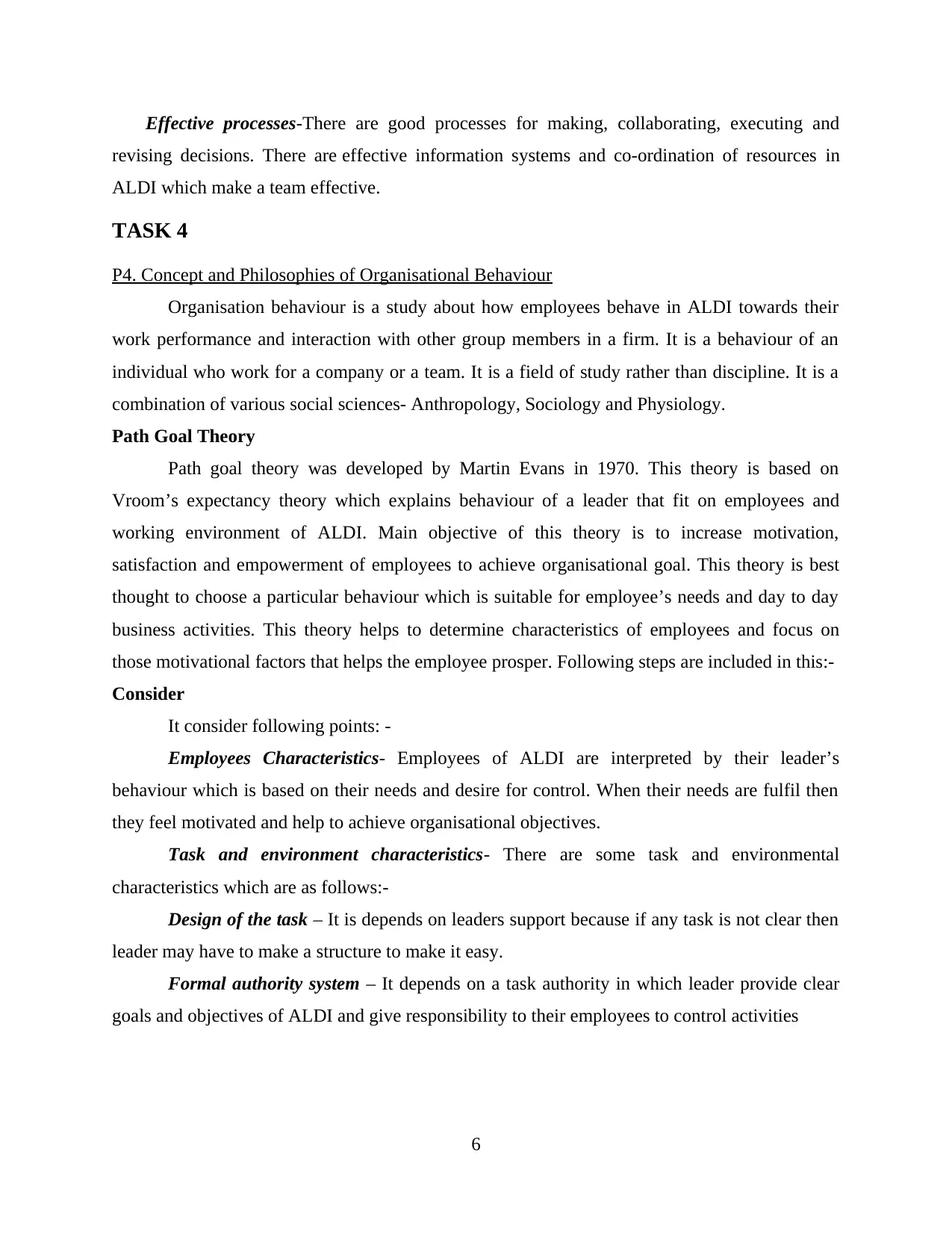
Effective processes-There are good processes for making, collaborating, executing and
revising decisions. There are effective information systems and co-ordination of resources in
ALDI which make a team effective.
TASK 4
P4. Concept and Philosophies of Organisational Behaviour
Organisation behaviour is a study about how employees behave in ALDI towards their
work performance and interaction with other group members in a firm. It is a behaviour of an
individual who work for a company or a team. It is a field of study rather than discipline. It is a
combination of various social sciences- Anthropology, Sociology and Physiology.
Path Goal Theory
Path goal theory was developed by Martin Evans in 1970. This theory is based on
Vroom’s expectancy theory which explains behaviour of a leader that fit on employees and
working environment of ALDI. Main objective of this theory is to increase motivation,
satisfaction and empowerment of employees to achieve organisational goal. This theory is best
thought to choose a particular behaviour which is suitable for employee’s needs and day to day
business activities. This theory helps to determine characteristics of employees and focus on
those motivational factors that helps the employee prosper. Following steps are included in this:-
Consider
It consider following points: -
Employees Characteristics- Employees of ALDI are interpreted by their leader’s
behaviour which is based on their needs and desire for control. When their needs are fulfil then
they feel motivated and help to achieve organisational objectives.
Task and environment characteristics- There are some task and environmental
characteristics which are as follows:-
Design of the task – It is depends on leaders support because if any task is not clear then
leader may have to make a structure to make it easy.
Formal authority system – It depends on a task authority in which leader provide clear
goals and objectives of ALDI and give responsibility to their employees to control activities
6
revising decisions. There are effective information systems and co-ordination of resources in
ALDI which make a team effective.
TASK 4
P4. Concept and Philosophies of Organisational Behaviour
Organisation behaviour is a study about how employees behave in ALDI towards their
work performance and interaction with other group members in a firm. It is a behaviour of an
individual who work for a company or a team. It is a field of study rather than discipline. It is a
combination of various social sciences- Anthropology, Sociology and Physiology.
Path Goal Theory
Path goal theory was developed by Martin Evans in 1970. This theory is based on
Vroom’s expectancy theory which explains behaviour of a leader that fit on employees and
working environment of ALDI. Main objective of this theory is to increase motivation,
satisfaction and empowerment of employees to achieve organisational goal. This theory is best
thought to choose a particular behaviour which is suitable for employee’s needs and day to day
business activities. This theory helps to determine characteristics of employees and focus on
those motivational factors that helps the employee prosper. Following steps are included in this:-
Consider
It consider following points: -
Employees Characteristics- Employees of ALDI are interpreted by their leader’s
behaviour which is based on their needs and desire for control. When their needs are fulfil then
they feel motivated and help to achieve organisational objectives.
Task and environment characteristics- There are some task and environmental
characteristics which are as follows:-
Design of the task – It is depends on leaders support because if any task is not clear then
leader may have to make a structure to make it easy.
Formal authority system – It depends on a task authority in which leader provide clear
goals and objectives of ALDI and give responsibility to their employees to control activities
6
⊘ This is a preview!⊘
Do you want full access?
Subscribe today to unlock all pages.

Trusted by 1+ million students worldwide
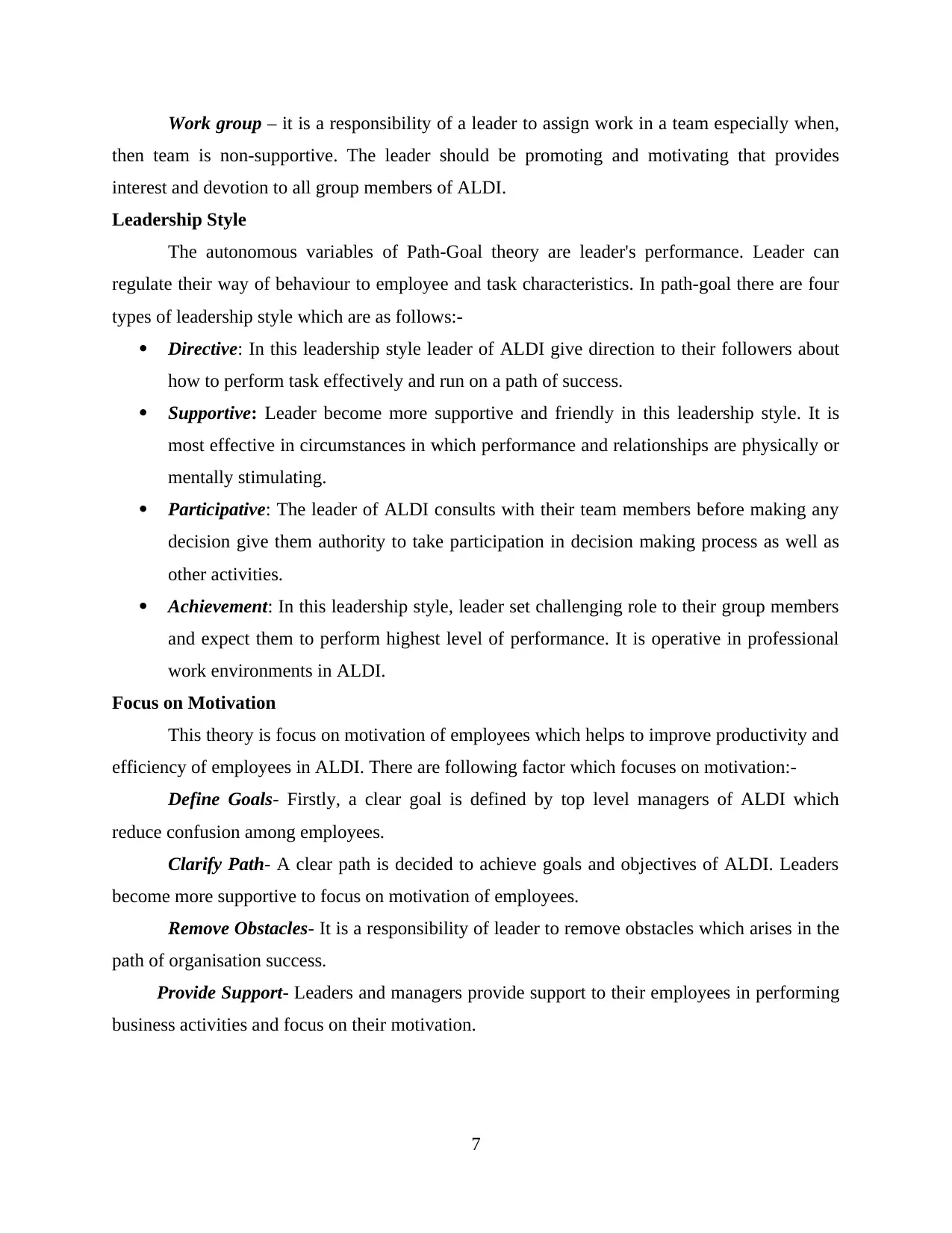
Work group – it is a responsibility of a leader to assign work in a team especially when,
then team is non-supportive. The leader should be promoting and motivating that provides
interest and devotion to all group members of ALDI.
Leadership Style
The autonomous variables of Path-Goal theory are leader's performance. Leader can
regulate their way of behaviour to employee and task characteristics. In path-goal there are four
types of leadership style which are as follows:-
Directive: In this leadership style leader of ALDI give direction to their followers about
how to perform task effectively and run on a path of success.
Supportive: Leader become more supportive and friendly in this leadership style. It is
most effective in circumstances in which performance and relationships are physically or
mentally stimulating.
Participative: The leader of ALDI consults with their team members before making any
decision give them authority to take participation in decision making process as well as
other activities.
Achievement: In this leadership style, leader set challenging role to their group members
and expect them to perform highest level of performance. It is operative in professional
work environments in ALDI.
Focus on Motivation
This theory is focus on motivation of employees which helps to improve productivity and
efficiency of employees in ALDI. There are following factor which focuses on motivation:-
Define Goals- Firstly, a clear goal is defined by top level managers of ALDI which
reduce confusion among employees.
Clarify Path- A clear path is decided to achieve goals and objectives of ALDI. Leaders
become more supportive to focus on motivation of employees.
Remove Obstacles- It is a responsibility of leader to remove obstacles which arises in the
path of organisation success.
Provide Support- Leaders and managers provide support to their employees in performing
business activities and focus on their motivation.
7
then team is non-supportive. The leader should be promoting and motivating that provides
interest and devotion to all group members of ALDI.
Leadership Style
The autonomous variables of Path-Goal theory are leader's performance. Leader can
regulate their way of behaviour to employee and task characteristics. In path-goal there are four
types of leadership style which are as follows:-
Directive: In this leadership style leader of ALDI give direction to their followers about
how to perform task effectively and run on a path of success.
Supportive: Leader become more supportive and friendly in this leadership style. It is
most effective in circumstances in which performance and relationships are physically or
mentally stimulating.
Participative: The leader of ALDI consults with their team members before making any
decision give them authority to take participation in decision making process as well as
other activities.
Achievement: In this leadership style, leader set challenging role to their group members
and expect them to perform highest level of performance. It is operative in professional
work environments in ALDI.
Focus on Motivation
This theory is focus on motivation of employees which helps to improve productivity and
efficiency of employees in ALDI. There are following factor which focuses on motivation:-
Define Goals- Firstly, a clear goal is defined by top level managers of ALDI which
reduce confusion among employees.
Clarify Path- A clear path is decided to achieve goals and objectives of ALDI. Leaders
become more supportive to focus on motivation of employees.
Remove Obstacles- It is a responsibility of leader to remove obstacles which arises in the
path of organisation success.
Provide Support- Leaders and managers provide support to their employees in performing
business activities and focus on their motivation.
7
Paraphrase This Document
Need a fresh take? Get an instant paraphrase of this document with our AI Paraphraser
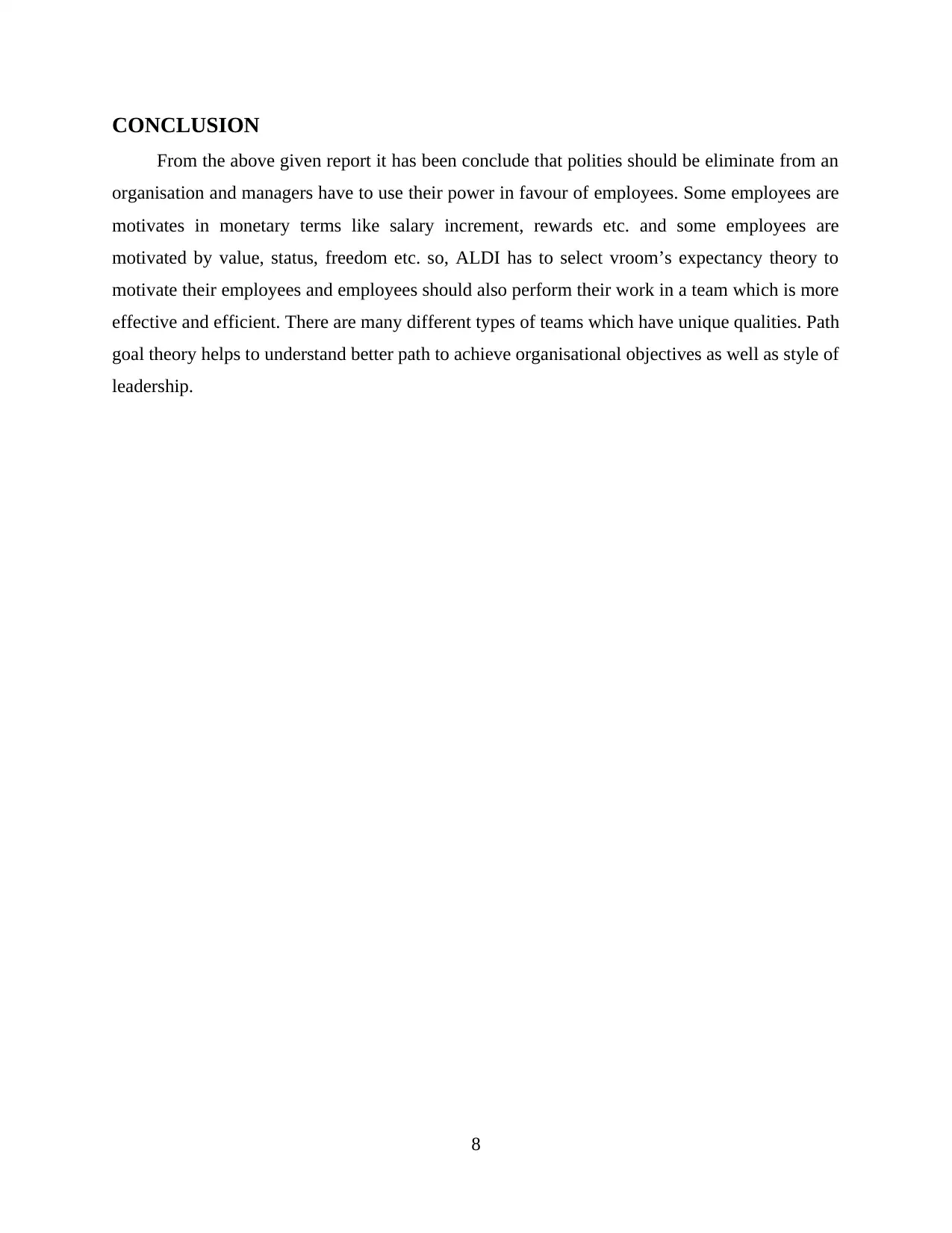
CONCLUSION
From the above given report it has been conclude that polities should be eliminate from an
organisation and managers have to use their power in favour of employees. Some employees are
motivates in monetary terms like salary increment, rewards etc. and some employees are
motivated by value, status, freedom etc. so, ALDI has to select vroom’s expectancy theory to
motivate their employees and employees should also perform their work in a team which is more
effective and efficient. There are many different types of teams which have unique qualities. Path
goal theory helps to understand better path to achieve organisational objectives as well as style of
leadership.
8
From the above given report it has been conclude that polities should be eliminate from an
organisation and managers have to use their power in favour of employees. Some employees are
motivates in monetary terms like salary increment, rewards etc. and some employees are
motivated by value, status, freedom etc. so, ALDI has to select vroom’s expectancy theory to
motivate their employees and employees should also perform their work in a team which is more
effective and efficient. There are many different types of teams which have unique qualities. Path
goal theory helps to understand better path to achieve organisational objectives as well as style of
leadership.
8
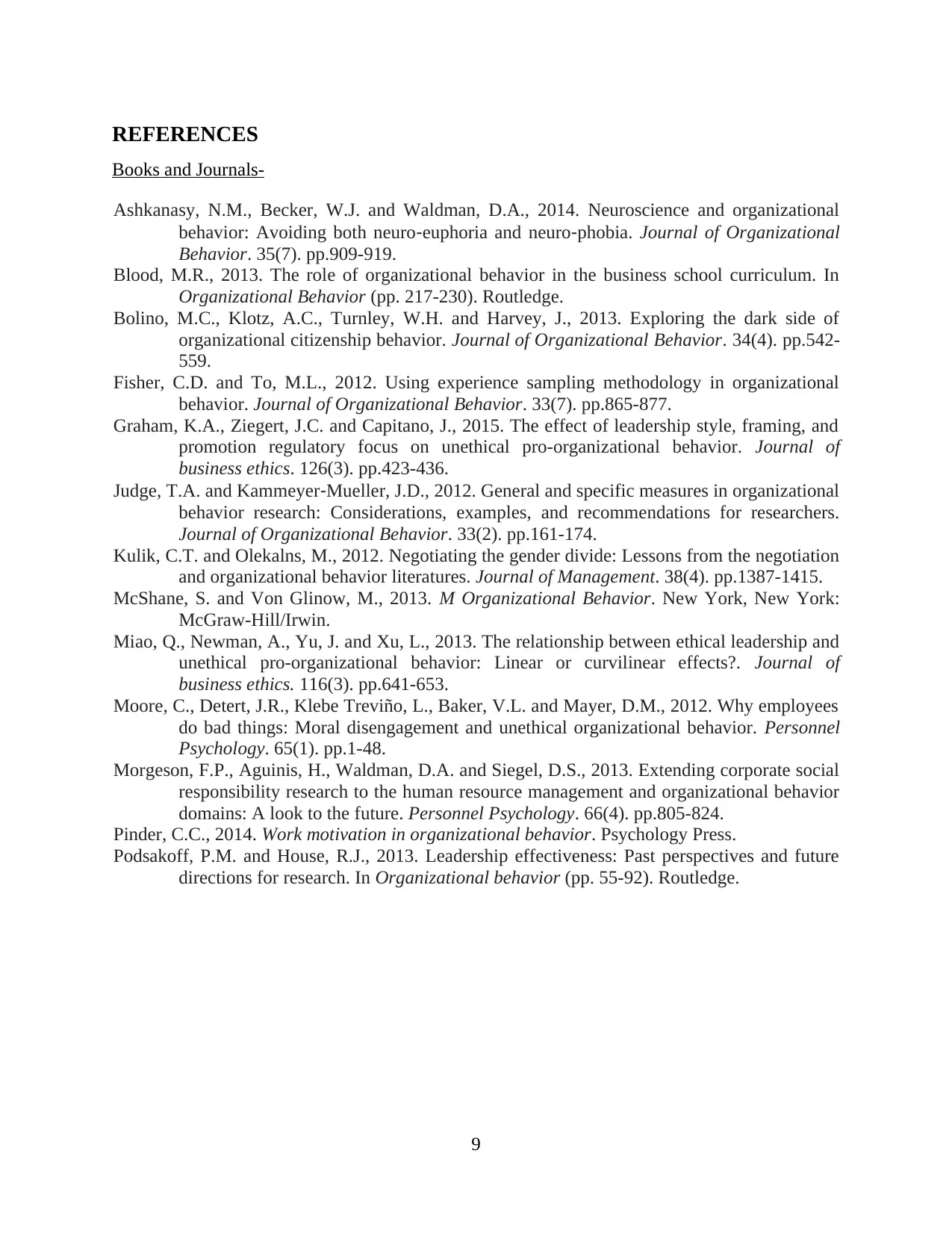
REFERENCES
Books and Journals-
Ashkanasy, N.M., Becker, W.J. and Waldman, D.A., 2014. Neuroscience and organizational
behavior: Avoiding both neuro‐euphoria and neuro‐phobia. Journal of Organizational
Behavior. 35(7). pp.909-919.
Blood, M.R., 2013. The role of organizational behavior in the business school curriculum. In
Organizational Behavior (pp. 217-230). Routledge.
Bolino, M.C., Klotz, A.C., Turnley, W.H. and Harvey, J., 2013. Exploring the dark side of
organizational citizenship behavior. Journal of Organizational Behavior. 34(4). pp.542-
559.
Fisher, C.D. and To, M.L., 2012. Using experience sampling methodology in organizational
behavior. Journal of Organizational Behavior. 33(7). pp.865-877.
Graham, K.A., Ziegert, J.C. and Capitano, J., 2015. The effect of leadership style, framing, and
promotion regulatory focus on unethical pro-organizational behavior. Journal of
business ethics. 126(3). pp.423-436.
Judge, T.A. and Kammeyer‐Mueller, J.D., 2012. General and specific measures in organizational
behavior research: Considerations, examples, and recommendations for researchers.
Journal of Organizational Behavior. 33(2). pp.161-174.
Kulik, C.T. and Olekalns, M., 2012. Negotiating the gender divide: Lessons from the negotiation
and organizational behavior literatures. Journal of Management. 38(4). pp.1387-1415.
McShane, S. and Von Glinow, M., 2013. M Organizational Behavior. New York, New York:
McGraw-Hill/Irwin.
Miao, Q., Newman, A., Yu, J. and Xu, L., 2013. The relationship between ethical leadership and
unethical pro-organizational behavior: Linear or curvilinear effects?. Journal of
business ethics. 116(3). pp.641-653.
Moore, C., Detert, J.R., Klebe Treviño, L., Baker, V.L. and Mayer, D.M., 2012. Why employees
do bad things: Moral disengagement and unethical organizational behavior. Personnel
Psychology. 65(1). pp.1-48.
Morgeson, F.P., Aguinis, H., Waldman, D.A. and Siegel, D.S., 2013. Extending corporate social
responsibility research to the human resource management and organizational behavior
domains: A look to the future. Personnel Psychology. 66(4). pp.805-824.
Pinder, C.C., 2014. Work motivation in organizational behavior. Psychology Press.
Podsakoff, P.M. and House, R.J., 2013. Leadership effectiveness: Past perspectives and future
directions for research. In Organizational behavior (pp. 55-92). Routledge.
9
Books and Journals-
Ashkanasy, N.M., Becker, W.J. and Waldman, D.A., 2014. Neuroscience and organizational
behavior: Avoiding both neuro‐euphoria and neuro‐phobia. Journal of Organizational
Behavior. 35(7). pp.909-919.
Blood, M.R., 2013. The role of organizational behavior in the business school curriculum. In
Organizational Behavior (pp. 217-230). Routledge.
Bolino, M.C., Klotz, A.C., Turnley, W.H. and Harvey, J., 2013. Exploring the dark side of
organizational citizenship behavior. Journal of Organizational Behavior. 34(4). pp.542-
559.
Fisher, C.D. and To, M.L., 2012. Using experience sampling methodology in organizational
behavior. Journal of Organizational Behavior. 33(7). pp.865-877.
Graham, K.A., Ziegert, J.C. and Capitano, J., 2015. The effect of leadership style, framing, and
promotion regulatory focus on unethical pro-organizational behavior. Journal of
business ethics. 126(3). pp.423-436.
Judge, T.A. and Kammeyer‐Mueller, J.D., 2012. General and specific measures in organizational
behavior research: Considerations, examples, and recommendations for researchers.
Journal of Organizational Behavior. 33(2). pp.161-174.
Kulik, C.T. and Olekalns, M., 2012. Negotiating the gender divide: Lessons from the negotiation
and organizational behavior literatures. Journal of Management. 38(4). pp.1387-1415.
McShane, S. and Von Glinow, M., 2013. M Organizational Behavior. New York, New York:
McGraw-Hill/Irwin.
Miao, Q., Newman, A., Yu, J. and Xu, L., 2013. The relationship between ethical leadership and
unethical pro-organizational behavior: Linear or curvilinear effects?. Journal of
business ethics. 116(3). pp.641-653.
Moore, C., Detert, J.R., Klebe Treviño, L., Baker, V.L. and Mayer, D.M., 2012. Why employees
do bad things: Moral disengagement and unethical organizational behavior. Personnel
Psychology. 65(1). pp.1-48.
Morgeson, F.P., Aguinis, H., Waldman, D.A. and Siegel, D.S., 2013. Extending corporate social
responsibility research to the human resource management and organizational behavior
domains: A look to the future. Personnel Psychology. 66(4). pp.805-824.
Pinder, C.C., 2014. Work motivation in organizational behavior. Psychology Press.
Podsakoff, P.M. and House, R.J., 2013. Leadership effectiveness: Past perspectives and future
directions for research. In Organizational behavior (pp. 55-92). Routledge.
9
⊘ This is a preview!⊘
Do you want full access?
Subscribe today to unlock all pages.

Trusted by 1+ million students worldwide
1 out of 12
Related Documents
Your All-in-One AI-Powered Toolkit for Academic Success.
+13062052269
info@desklib.com
Available 24*7 on WhatsApp / Email
![[object Object]](/_next/static/media/star-bottom.7253800d.svg)
Unlock your academic potential
Copyright © 2020–2025 A2Z Services. All Rights Reserved. Developed and managed by ZUCOL.





